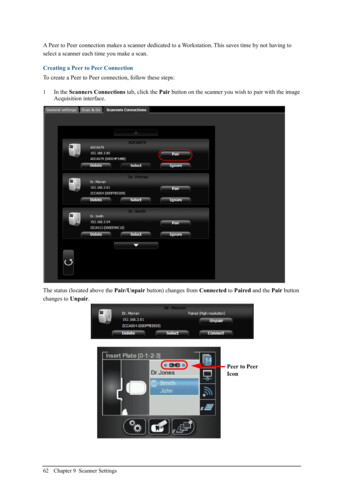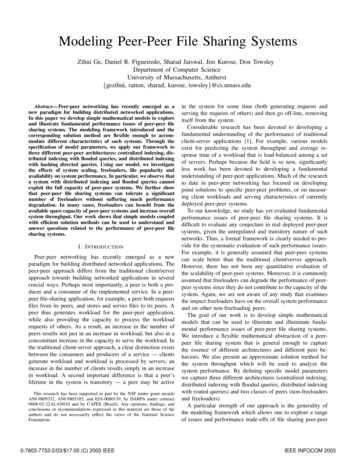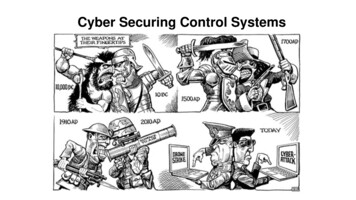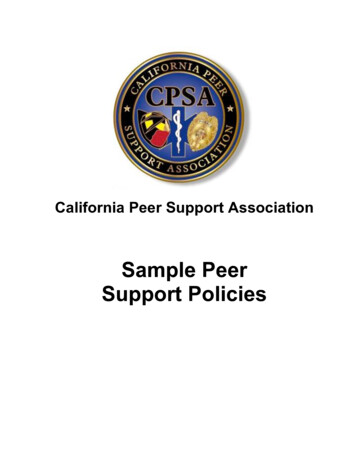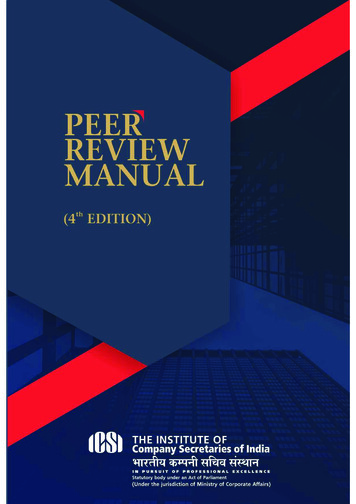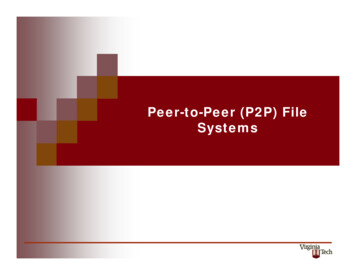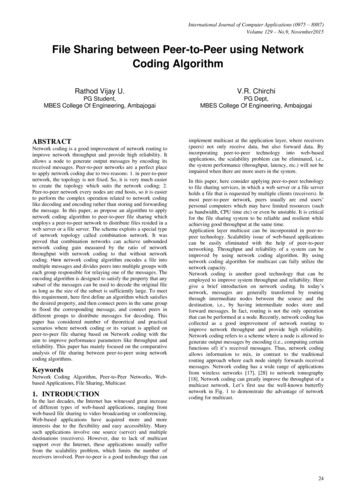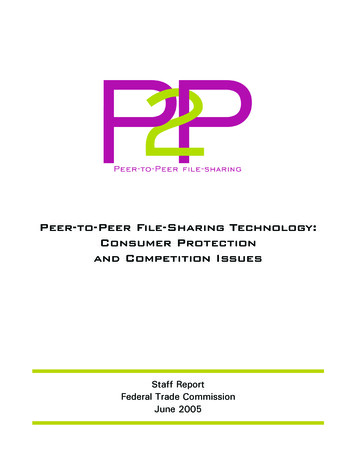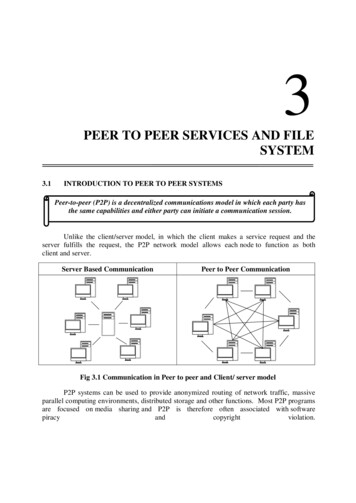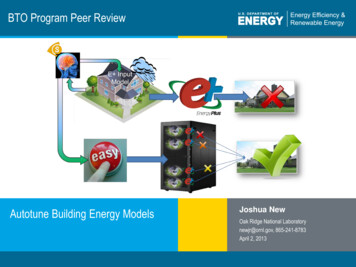
Transcription
BTO Program Peer ReviewAutotune Building Energy Models1 Program Name or Ancillary TextJoshua NewOak Ridge National Laboratorynewjr@ornl.gov, 865-241-8783April 2, 2013eere.energy.gov
Purpose & ObjectivesProblem Statement: “All (building energy) models are wrong, but some are useful”– 22%-97% different from utility data for 3,349 buildings More accurate models are more useful– Error from inputs and algorithms for practical reasons– Useful for cost-effective energy efficiency (EE) at speed and scale Calibration is required to be (legally) useful– ASHRAE G14 (NMBE 5/10% and CV(RMSE) 15/30% monthly/hourly) Manual calibration is risk/cost-prohibitive– Development costs 10-45% of federal ESPC projects 1M Need robust and scalable automated calibration for market– Adjusts parameters in a physically realistic manner– Scales to any available data and model (audit)2 Building Technologies Officeeere.energy.gov
Purpose & ObjectivesImpact of Project: Reduces transaction cost of developing and selling EEimprovement projects in existing buildings Enables the ESCO business model to reach smallerbuildings and projects Enables speed and scale deployment approaches basedon every building in served area having a continuouslymaintained calibrated model (audit) Enables tracked actual performance of implemented EEmeasures to improve model (audit) over timeProject endpoint is an automated calibration package thatusers of simulation tools can deploy as they choose.3 Building Technologies Officeeere.energy.gov
Purpose & ObjectivesProject Focus:Objective: Develop a generalized, automated model (audit)tuning methodology that enables the model (audit) toreproduce measured data as best it can, by selecting bestmatch input parameters in a systematic, automated, andrepeatable fashion.BTO Goals: supports the BTO overarching goal of reducingbuilding energy use 50% by 2030BTO strategic programs: Autotune is listed as a “keyservice” within the BTO Strategic BEM Portfolio4 Building Technologies Officeeere.energy.gov
ApproachApproach: Multi-objective optimization algorithms to minimize errorbetween simulation output and measured data byintelligently adjusting building model inputs Sensitivity analysis and uncertainty quantification todetermine importance of individual parameters Suite of machine learning algorithms to generatecalibration functions based on building dynamics Quantify trade-off between tuning accuracy and amountof data available Creation of intuitive Autotune application on user’s PC orwebsite with database, software tools, and acceleratedtuning agents in the background5 Building Technologies Officeeere.energy.gov
ApproachApproach: Demonstrations of end-to-end Autotune prototype on:– ORNL’s fleet of research houses and light commercial testbuildings (flexible research platforms)– Weatherization and audit buildings “in the wild”Key Issues: How well does it reproduce measured data? How long does it take? How well does this represent the actual building?6 Building Technologies Officeeere.energy.gov
ApproachDistinctive Characteristics: Method scalable to available data Methods employed are model (audit) agnostic Can be used to speed up model (audit) runtime Capabilities in place for big data mining Interactive dashboard for Autotune progress Repeatable tuning results7 Building Technologies Officeeere.energy.gov
Accomplishments and ProgressAccomplishments: End-to-end Windows desktop prototype created Overnight tuning of envelope-only parameters, 61% asaccurate as 4 man-months of effort Autotune 156 EnergyPlus inputs in 3 hours on desktopwas within 30 /day (actual use 4.97/day) Autotune for National Energy Audit Tool (NEAT)– 15 inputs ( 30%), reduced error 48%, 20mins on netbook– Experts would have tuned same way; 9,154 buildings Trinity test shows G14 compliance and realistic tuning– Outputs: CV(RMSE) 2.5%, NMBE 1% both hourly and monthly– Inputs: For 60% range, Autotune is close to real value (within 8%when tuning to hourly data, 15% when tuning to monthly data)8 Building Technologies Officeeere.energy.gov
Accomplishments and ProgressAccomplishments: Titan scalability – 65k cores, 262,144 EnergyPlus (9TB), 44mins MLSuite allows easy use ofhttp://autotune.roofcalc.comsoftware on supercomputers Tableau and Google Vis APIinteractive visualization andcomparison of all AutotuneexperimentsProgress on Goals: Tuning accuracy satisfies ASHRAE Guideline 14 Less than 3 hours on standard computer Physically realistic results9 Building Technologies Officeeere.energy.gov
Accomplishments and ProgressAwards/Recognition: 2 million core-hours, 4 competitive awards (free cost share) Extreme Science and Engineering DiscoveryEnvironment (XSEDE)– Nautilus 30k core-hours (CY11), 200k (CY12), 500k (CY13) Oak Ridge Leadership Computing Facility (OLCF)– Jaguar 500k core-hours (CY12), Titan 500k (CY13), Frost 200k(CY13), Lens/EVEREST (CY12&13)10 Building Technologies Officeeere.energy.gov
Project Plan & ScheduleProject initiation date: Oct. 2011 (FY12)Project planned completion date: Sept. 2014 (FY14)Schedule and Milestones:FY12 – 10 DOE deliverables on time and budgetFY13 – 7 of 14 DOE deliverables so far, all on time and budgetQ4 (Jul-Sep)Q3 (Apr-Jun)FY2014Q2 (Jan-Mar)Q4 (Jul-Sep)Q3 (Apr-Jun)FY2013Q2 (Jan-Mar)Q1 (Octt-Dec)Q4 (Jul-Sep)Q3 (Apr-Jun)FY2012Q2 (Jan-Mar)Task / Event312856DC, 312856DFFY12-08, FY13-02BT0201, BT0305Q1 (Octt-Dec)WBS Number or Agreement NumberProject NumberAgreement NumberLegendWork completedActive TaskMilestones & Deliverables (Original PlaMilestones & Deliverables (Actual)Q1 (Octt-Dec)SummaryProject Name: Autotune E Building ModelsD1) Sensitivity analysis of ZEBRAlliance E building modelD2) Mapping mechanism for E to sensor dataD3) Heterogeneous learning systems for directed variable tuningD4) Initial Autotune status and performance report1) Autotune Reporting2) Monthly utility bill calibration3) Building templates4) Autotune capabilities5) Reportingand Travel11 Building Technologies Officeeere.energy.gov
Project BudgetBudget HistoryCost to Date:– FY12: fully costed– FY13: 119k (45%)FY2012DOE 650kFY2013Cost-shareDOE 980k 264kCost-share 1,225kFunding Sources:FY12 Autotune ResourcesInternsHardware 3%6%LDRD(Weinberg)11%OLCF(Jaguar)34%12 Building Technologies OfficeFY13 Autotune ResourcesInterns &FacultyHardware 10%8%LDRD(Weinberg)12%DOE BTO40%UT(Nautilus)7%DOE BTO18%UT(Nautilus)15%OLCF(Titan)37%eere.energy.gov
Project Integration, Collaboration &Market ImpactPartners, Subcontractors, and Collaborators:Karpay AssociatesJacksonvilleState UniversityThe Universityof TennesseeTechnology Transfer, Deployment, Market Impact: Autotune Invention Disclosure filed 5 software systems to copyright and release Plan to deploy Autotune in FY1313 Building Technologies Officeeere.energy.gov
Project Integration, Collaboration &Market ImpactCommunications (selected):1 PhD Dissertation, 2 journals, 5 conference, 6 submitted soon, 5 internal reports (250 pages)Published: New, Joshua R., Sanyal, Jibonananda, Bhandari, Mahabir S., Shrestha, Som S. (2012). "Autotune EnergyPlusBuilding Energy Models." In Proceedings of the 5th National SimBuild of IBPSA-USA, International BuildingPerformance Simulation Association (IBPSA), Aug. 1-3, 2012. [PDF pre-print] Sanyal, Jibonananda, Al-Wadei, Yusof H., Bhandari, Mahabir S., Shrestha, Som S., Karpay, Buzz, Garret,Aaron L., Edwards, Richard E., Parker, Lynne E., and New, Joshua R. (2012). "Poster: Building Energy ModelCalibration using EnergyPlus, Machine Learning, and Supercomputing." In Proceedings of the 5th NationalSimBuild of IBPSA-USA, International Building Performance Simulation Association, Aug. 1-3, 2012. [PDF]Accepted: Garrett, Aaron, New, Joshua R., and Chandler, Theodore. “Evolutionary Tuning of Building Models to MonthlyElectrical Consumption”. ASHRAE Conference in Denver, CO, June 22-26, 2013. Sanyal, Jibonananda and New, Joshua R. “Simulation and Big Data Challenges in Tuning Building EnergyModels”. IEEE Workshop on Modeling and Simulation of Cyber-Physical Energy Systems, May 2013.Planned/submitted: Edwards, Richard E., New, Joshua R., and Parker, Lynne E. “Constructing Large Scale EnergyPlus Surrogatesfrom Big Data”. To be submitted to Energy & Buildings Journal, 2013. Garrett, Aaron and New, Joshua R. “Scalable Evolutionary Tuning of Building Models to Multiple Channels ofSub-Hourly Data”. To be submitted to ASHRAE, New York City, NY, Jan. 18-22, 2014.Internal: Edwards, Richard E., and Parker, Lynne E. (2013). “MLSuite - FY2012 Final Report”. 68 pages Garrett, Aaron and New, Joshua R. (2012). “An Evolutionary Approach to Parameter Tuning of BuildingModels”. 68 pages Edwards, Richard E., New, Joshua R., and Parker, Lynne E. (2012) “Approximate l-fold cross-validation withLeast Squares SVM and Kernel Ridge Regression”. 9 pages14 Building Technologies Officeeere.energy.gov
Next Steps and Future PlansNext Steps and Future Plans: BTO – finish Autotune project as detailed BTO – deploy in residential and commercial buildingintegration program elements Weatherization – Autotune NEAT comparison of humanvs. computer calibration Federal Energy Management Program – ESPC ENABLEprogram15 Building Technologies Officeeere.energy.gov
Objective: Develop a generalized, automated model (audit) tuning methodology that enables the model (audit) to reproduce measured data as best it can, by selecting best-match input parameters in a systematic, automated, and repeatable fashion. BTO Goals: supports the BTO overarching goal of reducing building energy use 50% by 2030
